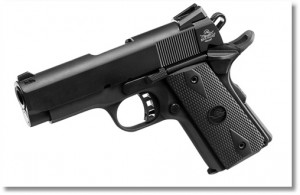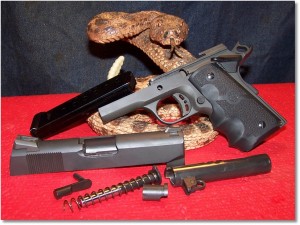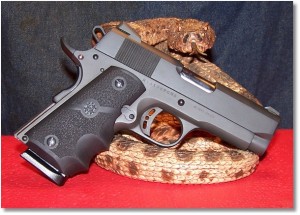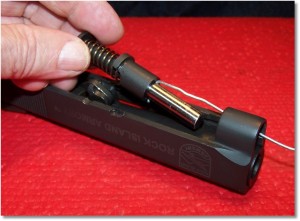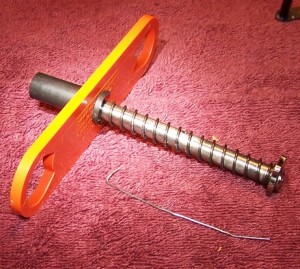I purchased one of the Rock Island Standard CS 45 pistols quite a while back when it was known as the Rock Island Tactical Officer. I have had no regrets in doing so, with one caveat that I’ll cover later in this article.
The Rock Island Standard CS 45 is your basic “Officer” length 1911-based pistol with a 3.5”, 6-groove, and 1:16 RH twist barrel. As found on many 1911 clones these days, the barrel is tapered at the muzzle end. After about 600-rounds through the pistol, the barrel locks up tight.With a 1911-based pistol of this type, a full-length guide rod is a necessary evil and evil it is. Although it helps with reliability and possible accuracy, it does not help when disassembling and assembling the pistol. I’ll touch on that later.
My pistol originally came with smooth wood grip panels of which were changed out to Hogue rubber wrap-around finger groove grips, which I believe is almost a necessity with this pistol, both from a recoil control aspect and controllability of the pistol. The smooth wood grip panels would probably work for most shooters but I like a larger grip. Because of the finish on the standard grip panels in the early model, I would not be surprised that the user would change them out for something better. The newer model; however, comes with double-diamond and checkered grip panels.Slide to frame fit is excellent and tight; I could not detect any play between the two. The frame and slide are Parkerized, and so far, this finish has held up well.
Front and rear sights are plain Jane, although the rear sight is sloped rearward to prevent snagging. I painted the front sight with white sight paint to help them stick out a bit. This gun is not a target gun, but can be an effective UCAP pistol for self-defense. As long as I can catch that front sight at least I know that the pistol is pointing in the right direction. I have not tried to swap out the sights for something better; the existing sights are fine for defensive work and I have heard that it was difficult to fit sights on this pistol (and all Rock Island) pistols because of the sight dovetail dimensions. I don’t know if that is true but I am not willing to spend the money to find out; These sights will do, thank you.
One issue on my particular pistol was the thumb safety; the plunger spring was weak and there was too much play (for me) with the safety. An aftermarket plunger spring and extended thumb safety was installed by my favorite gunsmith and now the thumb safety is stiffer and very positive moving in and out of safe. Note that the thumb safety that comes with the pistol is extended. The safety is left-side only.The beaver tail grip safety is nicely done with a memory bump; it extends far enough to keep you hand from crawling up too far on the grip. The mainspring housing is polymer and has vertical serrations. The hammer is skeletonized and serrated for easy cocking/decocking.
The slide lock is standard fare, but checkered for ease of use. I can reach the slide lock lever easily without really changing my grip – even with the Hogue rubber wrap-around finger grove grip. Your experience may differ, however.
The magazine release is not extended but is easy to reach and is also textured for easy purchase. The left-side only magazine release button releases magazines with no drag and magazines insert fully and lock in positively when inserted fully into the beveled magazine well. Magazine capacity is 7-rounds and a Nighthawk Custom Act-Mag magazine comes with the pistol. The RICS uses any 1911 magazine so replacements are easy to find.
For a pistol in this price range, the trigger is excellent and is a short-throw trigger. My RICS has a skeletonized trigger but lacks the over-travel adjustment of later models. Over-travel on my version of this pistol is virtually non-existent so no adjustment is needed. The trigger breaks crispy-clean at 4.5 pounds with very little take-up. In fact, I have more expensive 1911-based pistols that have more take-up and over-travel than this with this pistol.
The slide has fine vertical serrations on the rear of the slide for gripping. No press check capabilities are provided (front serrations), nor is a way to check for a chambered round; this must be done by slightly pulling the slide slightly rearward – just like in the old days. Of course, if I see a closed chamber, I automatically think that the pistol is loaded and chambered.
My version is roll-marked on the slide but lack the highlighting of later models.
The RICS, like “real” 1911-based pistols utilizes an internal extractor and “70” series features. On the same side as the extractor is the lowered and flared ejection port.
The RICS is very reminiscent of the original Colt “Officer” model with the exception of the finish; don’t expect polished blued steel on this one. With that said, and with this pistol made of steel, the pistol is heavy and weighs a healthy 2.16 pounds unloaded and 2.43 pounds with a full magazine of seven rounds and just a tad more with 7+1 rounds.
One of the major complaints is the disassembly technique with pistols using one piece guide rods. Unfortunately, with a pistol of this length of barrel, one piece guide rods are a necessity. Disassembly of the pistol is not that bad, really.After ensuring that the pistol is unloaded and the magazine removed, cock the hammer. Then, pull the slide rearward to engage the slide stop.
move the slide to the disassembly notch and remove the slide stop pin. Then, while holding the slide and frame, carefully slide the slide off the frame. There are two precautions in doing this; the recoil spring is not captive and if you are not careful, you can pinch the hand as the slide moves forward under tension – that will hurt. I usually force the slide rearward to the disassembly notch with the left hand. Then use the right hand to hold it in that position as I remove the slide stop with my weak hand. While still holding the slide, I use the left hand to slowly remove the slide from the frame.
Once the slide is off the frame, you can remove the guide rod and recoil spring; it might take some wiggling, as the there is a guide rod bushing that holds the guide rod in alignment. Once the guide rod and recoil spring is removed from the pistol, the guide rod bushing is removed toward the rear of the slide. The barrel can then be removed. In some cases; however, the guide rod is too tight inside the bushing to clear the frame that surrounds the swing link. In this case, the guide rod must be pushed forward under spring tension until the “captive” hole clears the front of the slide. A heavy paper clip is then inserted slightly through the hole. The paper clip holds the guide rod, recoil spring, and guide rod busing as an assembly. Then, the paper clip is bent forward, which allows the recoil guide “assembly” to be removed and the barrel is removed in the usual fashion. That was fun, huh?
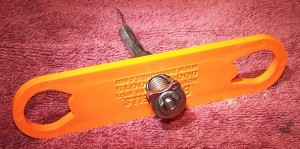
Modified Barrel Bushing Wrench Makes Disassmbling and Assembling the “Captive” Guide Rod Assembly Easy
The best is yet to come – assembling the pistol.
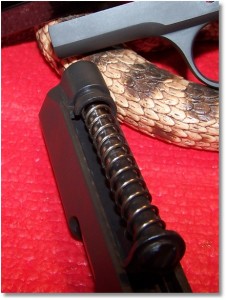
Guide Rod Bushing Butts Against the Inside of the Slide and is Held In Place under Spring Tension. In early Models, the Guide Rod Will Ride Up and Prevent the Slide From Being Installed On the Frame
In some pistols, the guide rod “assembly” can be pushed forward, and while holding the guide rod in place under spring tension, the paper clip is removed and the guide rod released slowly until it rests against the swing link base. The base of the guide rod tries to ride up and over the swing link and the frame cannot slide onto the slide fully, as the guide rod base prevents it from doing so.
Slightly push the guide rod forward and hold it against the barrel Slide the slide onto the frame, release the guide rod once it is in the frame, locate and press the slide stop through the swing link, and align the slide stop with the slide stop notch in the frame. The slide will be under spring tension until the Slide Stop is fully seated.
Pull the slide slightly to the rear to release the Slide Stop. Then, while holding the slide, allow the slide to move forward slowly until it is in battery.
Perform a function check.
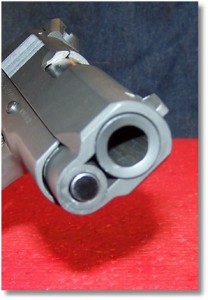
The Working End of the Rock Island Standard Compact – Note Marks on Recoil Guide Bushing From Using the Large and heavy Paper Clip Used During Disassembly and Assembly

Rock Island Standard Compact Rides Nicely in a Modified CBST Holster (The same holster that I now use for the Ruger SR1911CMD-A)
Aside from the initial light plunger spring and loose fitting thumb safety, which was easily corrected, the pistol has been a fine shooter with no failures to date. While slightly on the heavy side for concealed carry, it would make a fine pistol to have in one’s vehicle or when in environments where you do not want to bang up that more expensive defensive tool.
UPDATE 01/17/2016 – Bottom Drawer Pistol – Top Drawer Performance:
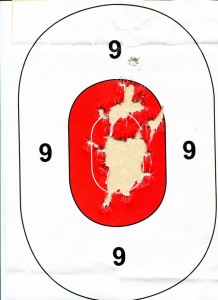
100 Rounds, 230-grain FMJ, 10-yards, offhand from Modified Weaver. First shot was high To Get My Bearings – Ninety-Nine Subsequent Shots Were Not
Granted, the Rock Island Armory family of 1911-based pistols are not top drawer. In fact, some would consider bottom drawer. Since I am a bottom drawer type of fellow, I own a couple of them. The first RIA pistol was a FS Standard – essentially the G.I Model. The RIA CS Standard was my second RIA purchase and it came with a somewhat loose thumb safety; it was quite the floppy fellow. I turned it into a gun smith for a replacement thumb safety and went from too loose to too tight. I doing the work myself to find a happy medium. Yesterday, I got the thumb safety to work better but it was still stiff – stiff enough to make my thumb sore trying to get it into the safe position. I thought that I would run the RIA CS this morning to (hopefully) loosen up the safety just a tad. While that did not happen, the performance of this pistol had several people considering the Rock Island Armory line of pistols.
I ran 100 rounds of 230-grain FMJ ammunition through three different magazines; a flush fit 7-round TRIPRESEARCH,com, a 7-round ACT-MAG that came with the pistol, and a Wilson Combat 7-round magazine with bumper pad. All three magazines worked just swimmingly. However, that is still not the point in all of this.
The accompanying image show the result of 100 rounds of 230-grain FMJ going downrange at 10-yards distance. My first shot was the one in the 9-ring. Once I figured out that the pistol is a POA pistol, the remaining 22,770 grains of JHP went in the 10-ring. Shooting was offhand and slow-fired from a modified Weaver with box stock sights (plain Jain “tactical” with no dots) and trigger that I can only say is fantastic considering the price of the pistol. There was also no failures out of this “Officer” model bottom-drawer 3.5-inch barreled pistol.
In my opinion, the Rock Island Armory 1911-based pistol family, like the Bersa family of pistols, is very underrated.
See the complete line of Armscor/Rock Island pistols @ https://us.armscor.com/products/
![]()


